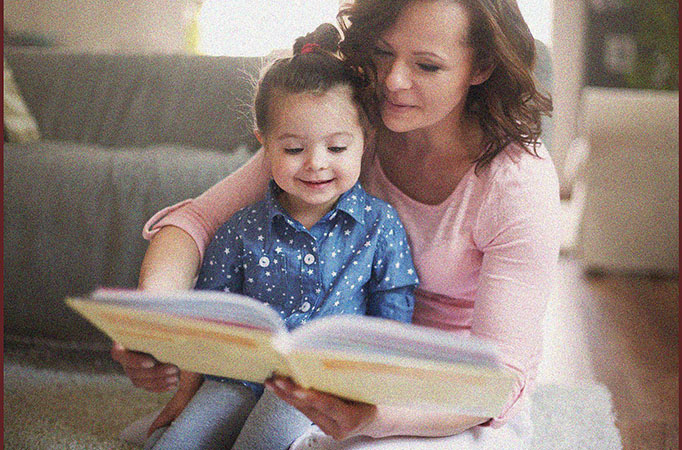Category: Reading
Blog Details
- Home
- Blog
01.07.2023
How Interactive Books Inspire Young Readers: Interactive books offer a unique reading experience that captivates children and sparks their love for stories.

Introduction: In a world filled with screens and distractions, fostering a love for reading in young children is more important than ever. Interactive books provide a captivating and engaging way to introduce children to the joy of reading. These books not only entertain but also inspire young readers, nurturing their imagination and curiosity. In this article, we will explore how interactive books can foster a love for reading from an early age and provide tips and strategies for parents to encourage reading habits in their children.
How Interactive Books Inspire Young Readers: Interactive books offer a unique reading experience that captivates children and sparks their love for stories. With their colorful illustrations, captivating narratives, and interactive elements, these books create an immersive world that captures children’s imagination. One such remarkable book is “Little Star” by Igor Vorobyov.
“Little Star” by Igor Vorobyov: A Magical Reading Experience: Introducing “Little Star,” a heartwarming and magical children’s book that teaches valuable lessons about kindness, friendship, and love for family. Written by author Igor Vorobyov with the assistance of a child psychologist and teacher, “Little Star” is designed to engage young children aged 3 to 7 years old and help them learn important life lessons in an interactive and captivating way.
This beautifully illustrated book is a must-have addition to any parent’s collection of children’s books, particularly for bedtime stories. “Little Star” weaves a heartwarming story with engaging characters that will quickly become a favorite for both parents and children. What sets “Little Star” apart is its innovative mobile app, which offers a unique reading experience that captures a child’s imagination, making it an exceptional addition to the world of baby books and children’s bedtime stories.
Tips for Parents to Encourage Reading Habits:
- 1. Start Early: Begin reading to your child from an early age to instill a love for books and storytelling.
- 2. Make Reading a Ritual: Set aside dedicated reading time each day, such as before bedtime or during quiet moments, to create a routine around reading.
- 3. Lead by Example: Let your child see you reading and enjoying books, as they are more likely to emulate behavior they observe.
- 4. Choose Age-Appropriate Books: Select books that align with your child’s age and interests, ensuring they are engaged and enthusiastic about the story.
- 5. Explore Different Genres: Introduce your child to various genres, such as fantasy, adventure, or non-fiction, to expand their interests and broaden their reading horizons.
- 6. Visit Libraries and Bookstores: Regularly take your child to libraries or bookstores to explore and choose books of their liking.
- 7. Make it Interactive: Encourage your child to actively participate while reading, such as asking questions, guessing what happens next, or even acting out scenes from the story.
Conclusion: Interactive books provide a gateway to a lifelong love for reading. By immersing children in captivating stories with engaging illustrations and interactive features, these books inspire young readers and make reading a fun and enjoyable experience. “Little Star” by Igor Vorobyov is a shining example of an interactive book that not only entertains but also imparts valuable life lessons. By implementing the tips and strategies mentioned above, parents can encourage reading habits in their children, fostering a love for books that will benefit them throughout their lives.
To experience the magic of “Little Star,” you can find the book on Amazon using the following link: Amazon Link – https://a.co/d/civl5Lc. It’s a heartwarming addition to your collection of children’s books, perfect for bedtime stories and inspiring young readers.
Blog Details
- Home
- Blog
12.02.2023
Reading is one of the most important skills a child can learn, and it starts at home.

Encouraging a love of reading from an early age is crucial to a child’s cognitive and emotional development. This is why creating a reading-friendly environment at home is so important.
Interactive Children’s Books
One way to make reading more engaging and enjoyable for children is by incorporating interactive children’s books into their reading routine. Interactive children’s books are designed to be both entertaining and educational, making them an excellent tool for teaching children valuable life lessons. The interactive elements, such as games and videos, capture a child’s imagination and help to bring the story to life, making reading a more interactive and enjoyable experience.
Igor Vorobyov – Children’s Book Author
Igor Vorobyov is a well-known author of interactive children’s books, who understands the power of storytelling in children’s development. His books are designed with the assistance of a child psychologist and teacher, to ensure they are both educational and entertaining. The books are perfect for children aged 3 to 7 years old and offer a fun and effective way to learn important life lessons.
Reading Environment
In addition to incorporating interactive children’s books into your child’s reading routine, it’s essential to create an environment that is conducive to reading. A quiet, cozy, and well-lit room is an excellent place to start. You can also consider investing in comfortable reading furniture, such as a beanbag or a cozy armchair, to encourage children to get lost in a good book.
Making Reading Time a Priority
Making reading time a special part of the day is another way to create a reading-friendly environment at home. You can designate a specific time each day for reading, such as before bed, or you can make it a weekly activity, such as a family reading night. This helps to establish reading as a routine and makes it a priority in your child’s life.
Choosing Books
Encouraging your child to choose their own books is also essential. Allowing them to pick books that interest them makes reading more enjoyable and increases their motivation to read. You can also encourage your child to participate in book clubs or library programs, where they can discuss books with other children and develop their social skills.
Being a Role Model
Finally, being a role model is one of the most important things you can do to encourage a love of reading in your child. Reading yourself and sharing your own love of books with your child will show them how important reading is, and it will also provide opportunities for quality bonding time.
In conclusion, creating a reading-friendly environment at home is essential for a child’s development. By incorporating interactive children’s books, such as those written by Igor Vorobyov, into your child’s reading routine, you can make reading a fun and interactive experience while teaching them important life lessons. A quiet, cozy, and well-lit room, making reading time a priority, and being a role model are just a few of the ways to make reading a more enjoyable and productive experience for your child.
Image by yanalya on Freepik
Blog Details
- Home
- Blog
12.02.2023
From the time we are young, storytelling has been a fundamental aspect of our lives.

Bedtime stories, fables, and fairy tales all have a significant impact on children’s development and growth. They have the power to engage a child’s imagination and curiosity, shaping their perspectives, beliefs, and behaviors.
The Benefits of Interactive Children’s Books
Interactive children’s books are a valuable tool for teaching life lessons. These books are not just entertaining but also an investment in a child’s future. By exposing them to a world of creativity, imagination, and exploration, interactive books help children develop their reading skills, vocabulary, and, most importantly, a love of learning.
Introducing Little Star
Little Star is a heartwarming and magical children’s book that teaches important life lessons. Written by author Igor Vorobyov with the assistance of a child psychologist and teacher, Little Star is designed for young children aged 3 to 7 years old to learn important life lessons in a fun and interactive way.
An Innovative Reading Experience
The Little Star book comes with a mobile app that brings the story to life with interactive scenes, video clips, and educational games. This innovative feature gives children the feeling of being a part of Little Star’s journey, making learning more effective and natural. Parents can also enjoy the book without the mobile app, as the heartwarming message and integrity of the story will not be compromised.
Follow Little Star’s Journey
As Little Star travels to different places, children will learn important life lessons alongside her. From how to behave and take care of themselves to how to tidy up at home and help their parents and friends, children will become more attentive and responsive.
The Magic of Bedtime Stories
Interactive children’s books like Little Star offer a unique and magical reading experience. Bedtime stories are an essential part of every child’s life, and interactive books like Little Star bring a new level of excitement to reading. Don’t miss this opportunity to make reading an interactive and fun experience for your child. Order Little Star today and watch as your child’s imagination takes flight while they learn valuable life lessons.
Investing in Your Child’s Future
In conclusion, the power of storytelling for children’s development is immense, and interactive children’s books like Little Star offer an innovative and effective way to engage a child’s imagination and teach important life lessons. Reading to children, especially at bedtime, is an investment in their future, so make sure to choose books that are both engaging and educational, such as Little Star.
Blog Details
- Home
- Blog
26.01.2023
Teaching children about emotions and emotional intelligence is crucial for their overall development and well-being.

Emotional intelligence, or the ability to understand and manage one’s own emotions and the emotions of others, is a key skill that can help children navigate the challenges of life and form healthy relationships.
One of the best ways to teach children about emotions and emotional intelligence is through books. Children’s books that deal with emotions and relationships can be a valuable tool for helping children understand and express their own feelings and empathize with others. One example of such a book is Little Star by Igor Vorobyov. This interactive children’s book tells the story of Little Star who is learning about the world and the emotions that come with it. The book comes with a mobile app that brings the story to life with interactive scenes, video clips, and educational games, all triggered by scanning QR codes on the pages of the book. This innovative feature gives children the feeling of truly being a part of Little Star’s journey, making learning more effective and natural.
One of the key elements of teaching children about emotions and emotional intelligence is helping them to understand that emotions are normal and healthy. Children need to learn that it is okay to feel a wide range of emotions, and that different emotions can be appropriate in different situations. Teaching children to recognize and name their emotions can help them to understand and express them more effectively.
Another important aspect of teaching children about emotions and emotional intelligence is helping them to understand the emotions of others. Children need to learn how to read the nonverbal cues and expressions of others, and to empathize with their feelings. Books can be a great tool for teaching children about the emotions of others, as they can provide examples of characters dealing with different emotions in different situations.
In addition, teaching children about emotions and emotional intelligence can also include encouraging them to practice mindfulness and meditation. This can help children to focus on the present moment and to be more aware of their own thoughts and emotions.
In conclusion, teaching children about emotions and emotional intelligence is crucial for their overall development and well-being. Books like Little Star by Igor Vorobyov can be a valuable tool for helping children understand and express their own feelings, empathize with others, and practice mindfulness and meditation. It is essential for parents to make sure that their children have access to books that will help them learn about emotions and emotional intelligence in a fun and engaging way.
Image by gpointstudio on Freepik
Blog Details
- Home
- Blog
25.01.2023
As children grow and develop, their reading abilities and interests also change.

One of the milestones in a child’s reading journey is the transition from picture books to chapter books. This transition can be exciting but also challenging for both parents and children. However, with the right approach and some guidance, it can be a smooth and enjoyable experience for everyone.
1. Introduce new vocabulary and grammar structures: Chapter books tend to have more complex language and sentence structures than picture books. To help your child understand and engage with the new material, introduce new vocabulary and grammar structures gradually. This can be done through reading together, playing word games, or using flashcards.
2. Encourage independent reading: Once your child is comfortable with the new vocabulary and grammar structures, encourage them to read independently. This will help them to develop their reading fluency and comprehension skills.
3. Provide guidance and support: As your child begins to read chapter books, provide guidance and support. Help them to understand the story, characters, and themes. Discuss the book with them, ask them questions and encourage them to express their thoughts and feelings.
4. Use engaging children’s books: When choosing chapter books, it is important to select engaging children’s books that match your child’s interests and reading level. Look for books that have relatable characters, exciting plots, and illustrations that will help your child to visualize the story.
5. Make reading fun: Lastly, make reading fun. Create a cozy reading nook, encourage your child to read with a stuffed animal or blanket, or read a chapter together before bedtime.
In conclusion, transitioning from picture books to chapter books can be an exciting but challenging experience. By introducing new vocabulary and grammar structures, encouraging independent reading, providing guidance and support, using engaging children’s books and making reading fun, you can help your child make the transition smoothly.
Image from fxquadro on Freepik
Blog Details
- Home
- Blog
22.01.2023
Monday mornings can be a tough time for families, with everyone trying to start the week off on the right foot. That’s why, on Mondays, we like to share some motivation to help kick-start the week. Today, we’re talking about the importance of reading to children.

Reading to children is one of the most important things parents can do to help their child’s development and future success. Studies have shown that children who are read to regularly have better language skills, a larger vocabulary, and a stronger ability to focus. They also tend to perform better in school and have a higher chance of graduating from college.
Reading to children also helps to promote a love of learning and a love of books, which can lead to a lifetime of learning and personal growth. It also helps to develop empathy, imagination, and creativity. Children who are read to also have a better understanding of the world around them, and can develop a sense of wonder and curiosity.
Reading to children is also a great way to bond with your child. It’s a special time where you can share a story and create memories together. It’s also a great way to relax and unwind after a busy day.
The benefits of reading to children are clear, and the best part is that it’s easy to do. You can read to your child at any time of the day, and it doesn’t have to be a long process. Just a few minutes of reading can make a big difference.
So, on this Monday morning, let’s make a commitment to read to our children. Whether it’s a few minutes before bed, during lunch, or even on the way to school, let’s make reading a part of our daily routine. Together, we can help our children develop a love of learning and set them up for a bright future.
Blog Details
- Home
- Blog
22.01.2023
Reading is an essential skill that children need to develop in order to succeed in life. However, it can be difficult to get children to pick up a book and read on their own, especially when it comes to children’s books.

As parents, it’s our job to make reading fun and enjoyable for our children through children’s books. Incorporating reading into a child’s daily routine can help to make it a habit, and eventually a joy through children’s books.
Here are some fun and creative ways to incorporate reading into your child’s day through children’s books:
1. Make it a part of the bedtime routine: Reading before bed can be a great way to wind down and relax. Make it a part of your child’s bedtime routine and let them pick out a children’s book to read before they go to sleep.
2. Create a reading corner: Designate a special reading area in your home. It could be a cozy corner in the living room, a tent in their room, or a hammock in the backyard, filled with children’s books.
3. Turn it into a game: Incorporate reading into a game through children’s books. For example, make flashcards with words or pictures on them and have your child match them to the words in the children’s book.
4. Reading scavenger hunt: Create a scavenger hunt where your child has to find certain words or phrases in a children’s book. This can make reading more interactive and fun.
5. Reading with friends: Encourage your child to read with friends through children’s books. It could be through a book club or just reading together over a video call.
6. Audio books: Audio books can be a great way to incorporate reading into a child’s day through children’s books. They can listen to it while they are doing other activities such as driving, going for a walk or doing chores.
7. Reading challenge: Set a reading challenge for your child through children’s books. For example, read a certain number of books in a month or read a book from every continent.
8. Cook together: Incorporate reading into cooking by finding a recipe in a cookbook and reading it together before cooking the dish.
Remember, the key is to make reading fun and enjoyable through children’s books. With these tips, you can help your child develop a love for reading and make it a part of their daily routine through children’s books.
Blog Details
- Home
- Blog
21.01.2023
As parents, we want to give our children the best start in life. One of the most important ways we can do this is by encouraging them to develop a love of reading.

Reading is an essential skill that children need to develop in order to succeed in life. Not only does it improve their literacy skills, but it also opens up a whole world of imagination and knowledge through children’s books. However, for some children, reading can be a daunting task. As parents, it’s our job to make reading fun and enjoyable for our children through children’s books.
Here are some tips for parents on how to encourage a love of reading in children:
1. Start early: The earlier you introduce your child to reading, the more likely they are to develop a love for it. Even if your child is not yet ready to read, you can still read to them and expose them to books.
2. Make it a part of daily routine: Incorporate reading into your child’s daily routine. Make it a part of their bedtime routine or have a designated time of the day for reading.
3. Make it interactive: Make reading an interactive experience for your child. Ask them questions about the story, let them act out the story, or even make their own book.
4. Let them choose: Give your child the freedom to choose the books they want to read. This will give them a sense of control and help them to take ownership of their reading.
5. Lead by example: Children often mimic the behavior of the adults around them. If they see you reading, they are more likely to develop a love for it themselves.
6. Use technology: Incorporate technology into your child’s reading experience. There are many interactive books and reading apps available that can make reading more engaging.
7. Encourage reading aloud: Encourage your child to read aloud to you or to others. This will help them to improve their pronunciation and fluency.
8. Make it a family activity: Make reading a family activity. Encourage your whole family to read together and discuss the books you have read.
Remember, the key is to make reading fun and enjoyable. With these tips, you can help your child develop a love for reading and set them on the path to success.

